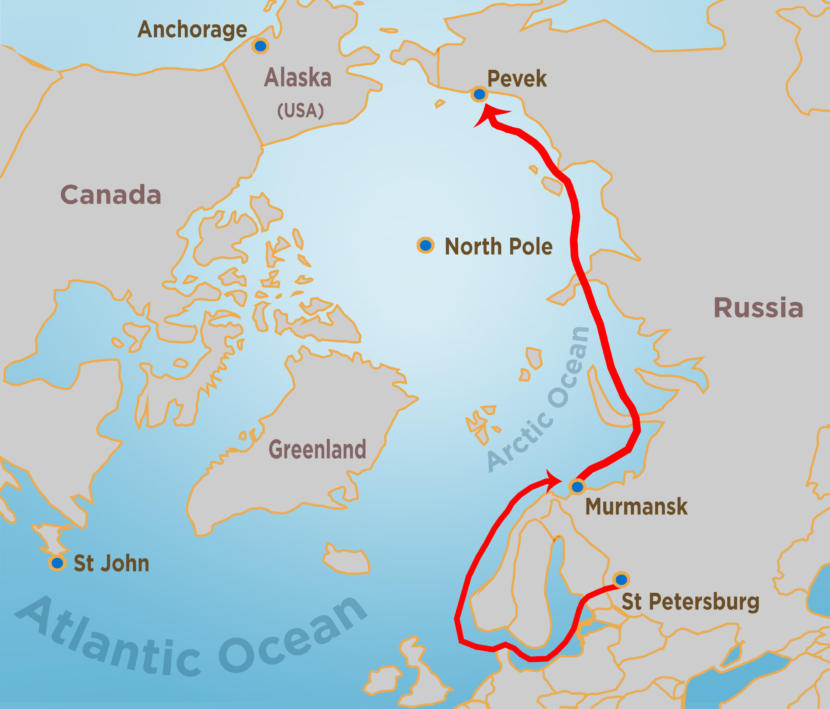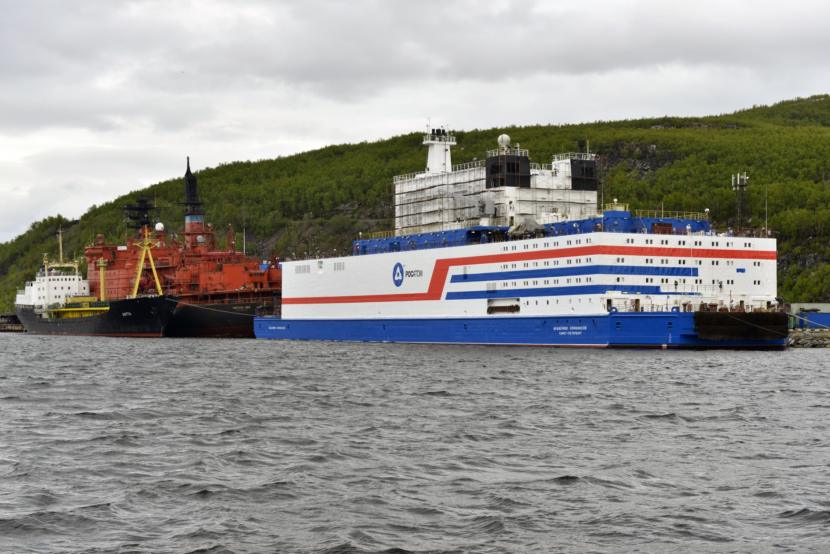
Russia has produced the world’s first floating nuclear power plant.
A barge mounted with nuclear reactors is expected to begin traversing the Arctic Ocean this month, bound for the Chukotka Peninsula. Across the Bering Strait, Alaskans are worried about radiation, though one Arctic security expert also sees room for optimism.
Russia hasn’t been keeping this project a secret. Reporters have documented the fanfare, at the vessel’s launch in St. Petersburg and its stop in Murmansk where it picked up nuclear fuel, along with a new paint job. It’s now white, red and blue — the colors of the Russia flag.
Journalists have been allowed to tour the barge-mounted facilities, which include a sauna, a swimming pool and gym.
“Some facilities, like the engine room, are fully automatic. It’s been tested, and it operates perfectly,” chief construction officer Andrei Talus told Russia24, a state-owned TV network.
The 472-foot barge is called the Akademik Lomonosov. Environmental groups like Greenpeace call it “Chernobyl on ice.”
Each of its twin nuclear reactors is capable of powering a city roughly the size of Fairbanks. The government-owned nuclear power company Rosatom says the plan is to dock at the city of Pevek, in northeastern Siberia, and provide heat and power to the mining region.
At the launch event, chief engineer Viktor Yelagin told Russia24 reporters the design combines elements from the transport power units used in nuclear icebreakers and the designs of stationary nuclear power plants. He said it has a state-of-the-art security system.

But many remember that Japan used to promise its Fukushima nuclear power plant was safe, too. Then a tsunami struck in 2011, causing meltdowns and radioactive emissions. Bering Sea villagers learned this spring that radiation was detected in sea water samples they collected — though Alaska state epidemiologists said the radiation levels are very low and are not a health concern.
“It’s small. you know, not dangerous. But traceable to Fukushima,” said Austin Ahmasuk, a marine advocate for Kawerak, the Native nonprofit serving the Bering Straits area.
He said the nuclear barge feels like one more source of potential danger to track in a region that’s warming at an alarming rate. He’s especially worried about cumulative effects.
“Radiation effects, environmental effects — we’ve been worried about for quite some time in this era of increased shipping, less sea ice,” Ahmasuk said.
Bering Straits Native Corporation CEO Gail Schubert said the barge is a big worry for her.
“It’s personally really concerning to me,” she said at an Arctic conference in Washington, D.C., last month. “I appreciate that they want to bring power to some of their coastal villages in the Chukotka region. But I think that a lot of folks in my region are not excited about having a floating nuclear power plant brought into the region itself.”

Russia’s nuclear track record does not inspire a ton of confidence, said Rebecca Pincus, an Arctic security expert at the U.S. Naval War College in Rhode Island. There was the Chernobyl meltdown in 1986, of course, but a quick Google search reveals other worrying incidents, too.
“‘Mysterious cloud of radioactive particles detected above much of Europe in 2017,’” Pincus said, reading from her computer screen. “‘Dramatic radiation surge. Denials at the time by Russian authorities.’ Right?”
On the other hand, Pincus said there’s reason to believe the Russians will do their best with the nuclear barge, because they have a lot of national pride on the line. Pincus said they strive to be the frontrunner in Arctic development.
“The Russian authorities are developing the Arctic because its of tremendous importance to them. And they recognize that it’s happening in a fishbowl,” she said. “You know, the world is watching what’s going on in the Russian Arctic. And so I think there is a tremendous amount of scrutiny and pressure to ensure that nothing goes wrong.”
And if it goes right? Well, the Alaska delegation to Congress has for years explored the idea of small nuclear reactors for their own off-grid communities. Pincus said maybe one day Arctic Council countries will discuss ways to replicate Russia’s nuclear barge success story.
“This would be a perfect opportunity to say, ‘Hey … we find what you are doing interesting. We would like to learn more,’ and try to make it sort of a positive avenue for information sharing,” she said.
The Akademik Lomonosov is expected to begin producing power for Chukotka in December.